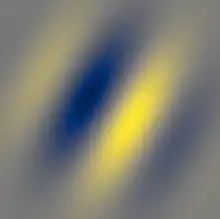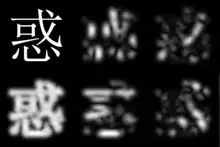Gabor filter
In image processing, a Gabor filter, named after Dennis Gabor, is a linear filter used for texture analysis, which essentially means that it analyzes whether there is any specific frequency content in the image in specific directions in a localized region around the point or region of analysis. Frequency and orientation representations of Gabor filters are claimed by many contemporary vision scientists to be similar to those of the human visual system.[1] They have been found to be particularly appropriate for texture representation and discrimination. In the spatial domain, a 2D Gabor filter is a Gaussian kernel function modulated by a sinusoidal plane wave (see Gabor transform).

Some authors claim that simple cells in the visual cortex of mammalian brains can be modeled by Gabor functions.[2][3] Thus, image analysis with Gabor filters is thought by some to be similar to perception in the human visual system.
Definition
Its impulse response is defined by a sinusoidal wave (a plane wave for 2D Gabor filters) multiplied by a Gaussian function.[4] Because of the multiplication-convolution property (Convolution theorem), the Fourier transform of a Gabor filter's impulse response is the convolution of the Fourier transform of the harmonic function (sinusoidal function) and the Fourier transform of the Gaussian function. The filter has a real and an imaginary component representing orthogonal directions.[5] The two components may be formed into a complex number or used individually.
Complex
Real
Imaginary
where
and
In this equation, represents the wavelength of the sinusoidal factor, represents the orientation of the normal to the parallel stripes of a Gabor function, is the phase offset, is the sigma/standard deviation of the Gaussian envelope and is the spatial aspect ratio, and specifies the ellipticity of the support of the Gabor function.
Wavelet space

Gabor filters are directly related to Gabor wavelets, since they can be designed for a number of dilations and rotations. However, in general, expansion is not applied for Gabor wavelets, since this requires computation of bi-orthogonal wavelets, which may be very time-consuming. Therefore, usually, a filter bank consisting of Gabor filters with various scales and rotations is created. The filters are convolved with the signal, resulting in a so-called Gabor space. This process is closely related to processes in the primary visual cortex.[6] Jones and Palmer showed that the real part of the complex Gabor function is a good fit to the receptive field weight functions found in simple cells in a cat's striate cortex.[7]
Extraction of features from images
A set of Gabor filters with different frequencies and orientations may be helpful for extracting useful features from an image.[8] In the discrete domain, two-dimensional Gabor filters are given by,
where B and C are normalizing factors to be determined.
2-D Gabor filters have rich applications in image processing, especially in feature extraction for texture analysis and segmentation.[9] defines the frequency being looked for in the texture. By varying , we can look for texture oriented in a particular direction. By varying , we change the support of the basis or the size of the image region being analyzed.
Applications of 2-D Gabor filters in image processing
In document image processing, Gabor features are ideal for identifying the script of a word in a multilingual document.[10] Gabor filters with different frequencies and with orientations in different directions have been used to localize and extract text-only regions from complex document images (both gray and colour), since text is rich in high frequency components, whereas pictures are relatively smooth in nature.[11][12][13] It has also been applied for facial expression recognition [14] Gabor filters have also been widely used in pattern analysis applications. For example, it has been used to study the directionality distribution inside the porous spongy trabecular bone in the spine.[15] The Gabor space is very useful in image processing applications such as optical character recognition, iris recognition and fingerprint recognition. Relations between activations for a specific spatial location are very distinctive between objects in an image. Furthermore, important activations can be extracted from the Gabor space in order to create a sparse object representation.
Example implementations
(Code for Gabor feature extraction from images in MATLAB can be found at http://www.mathworks.com/matlabcentral/fileexchange/44630.)
This is an example implementation in Python:
import numpy as np
def gabor(sigma, theta, Lambda, psi, gamma):
"""Gabor feature extraction."""
sigma_x = sigma
sigma_y = float(sigma) / gamma
# Bounding box
nstds = 3 # Number of standard deviation sigma
xmax = max(abs(nstds * sigma_x * np.cos(theta)), abs(nstds * sigma_y * np.sin(theta)))
xmax = np.ceil(max(1, xmax))
ymax = max(abs(nstds * sigma_x * np.sin(theta)), abs(nstds * sigma_y * np.cos(theta)))
ymax = np.ceil(max(1, ymax))
xmin = -xmax
ymin = -ymax
(y, x) = np.meshgrid(np.arange(ymin, ymax + 1), np.arange(xmin, xmax + 1))
# Rotation
x_theta = x * np.cos(theta) + y * np.sin(theta)
y_theta = -x * np.sin(theta) + y * np.cos(theta)
gb = np.exp(-.5 * (x_theta ** 2 / sigma_x ** 2 + y_theta ** 2 / sigma_y ** 2)) * np.cos(2 * np.pi / Lambda * x_theta + psi)
return gb
For an implementation on images, see .
This is an example implementation in MATLAB/Octave:
function gb=gabor_fn(sigma, theta, lambda, psi, gamma)
sigma_x = sigma;
sigma_y = sigma / gamma;
% Bounding box
nstds = 3;
xmax = max(abs(nstds * sigma_x * cos(theta)), abs(nstds * sigma_y * sin(theta)));
xmax = ceil(max(1, xmax));
ymax = max(abs(nstds * sigma_x * sin(theta)), abs(nstds * sigma_y * cos(theta)));
ymax = ceil(max(1, ymax));
xmin = -xmax; ymin = -ymax;
[x,y] = meshgrid(xmin:xmax, ymin:ymax);
% Rotation
x_theta = x * cos(theta) + y * sin(theta);
y_theta = -x * sin(theta) + y * cos(theta);
gb = exp(-.5*(x_theta.^2/sigma_x^2+y_theta.^2/sigma_y^2)).*cos(2*pi/lambda*x_theta+psi);
This is another example implementation in Haskell:
import Data.Complex (Complex((:+)))
gabor λ θ ψ σ γ x y = exp ( (-0.5) * ((x'^2 + γ^2*y'^2) / (σ^2)) :+ 0) * exp ( 0 :+ (2*pi*x'/λ+ψ) )
where x' = x * cos θ + y * sin θ
y' = -x * sin θ + y * cos θ
(Note: a :+ b should be read as )
References
- Olshausen, B. A. & Field, D. J. (1996). "Emergence of simple-cell receptive-field properties by learning a sparse code for natural images". Nature. 381 (6583): 607–609. Bibcode:1996Natur.381..607O. doi:10.1038/381607a0. PMID 8637596. S2CID 4358477.CS1 maint: multiple names: authors list (link)
- Marčelja, S. (1980). "Mathematical description of the responses of simple cortical cells". Journal of the Optical Society of America. 70 (11): 1297–1300. Bibcode:1980JOSA...70.1297M. doi:10.1364/JOSA.70.001297. PMID 7463179.
- Daugman, John G. (1985-07-01). "Uncertainty relation for resolution in space, spatial frequency, and orientation optimized by two-dimensional visual cortical filters". Journal of the Optical Society of America A. 2 (7): 1160–9. Bibcode:1985JOSAA...2.1160D. CiteSeerX 10.1.1.465.8506. doi:10.1364/JOSAA.2.001160. ISSN 1084-7529. PMID 4020513.
- Fogel, I.; Sagi, D. (June 1989). "Gabor filters as texture discriminator". Biological Cybernetics. 61 (2). CiteSeerX 10.1.1.367.2700. doi:10.1007/BF00204594. ISSN 0340-1200. OCLC 895625214. S2CID 14952808.
- 3D surface tracking and approximation using Gabor filters, Jesper Juul Henriksen, South Denmark University, March 28, 2007
- Daugman, J.G. (1980), "Two-dimensional spectral analysis of cortical receptive field profiles", Vision Res., 20 (10): 847–56, doi:10.1016/0042-6989(80)90065-6, PMID 7467139, S2CID 40518532
- Jones, J.P.; Palmer, L.A. (1987). "An evaluation of the two-dimensional gabor filter model of simple receptive fields in cat striate cortex" (PDF). J. Neurophysiol. 58 (6): 1233–1258. doi:10.1152/jn.1987.58.6.1233. PMID 3437332. S2CID 16809045.
- Haghighat, M.; Zonouz, S.; Abdel-Mottaleb, M. (2013). "Identification Using Encrypted Biometrics". Computer Analysis of Images and Patterns. Lecture Notes in Computer Science. 8048. p. 440. doi:10.1007/978-3-642-40246-3_55. ISBN 978-3-642-40245-6.
- Ramakrishnan, A.G.; Kumar Raja, S.; Raghu Ram, H.V. (2002). "Neural network-based segmentation of textures using Gabor features" (PDF). Proceedings of the 12th IEEE Workshop on Neural Networks for Signal Processing. Martigny, Switzerland: IEEE: 365–374. doi:10.1109/NNSP.2002.1030048. ISBN 978-0-7803-7616-8. OCLC 812617471. S2CID 10994982.
- Pati, Peeta Basa; Ramakrishnan, A.G. (July 2008). "Word level multi-script identification". Pattern Recognition Letters. 29 (9): 1218–1229. doi:10.1016/j.patrec.2008.01.027. ISSN 0167-8655.
- Raju S, S.; Pati, P.B.; Ramakrishnan, A.G. (2004). "Gabor filter based block energy analysis for text extraction from digital document images" (PDF). First International Workshop on Document Image Analysis for Libraries, 2004. Proceedings. Palo Alto, CA, USA: IEEE: 233–243. doi:10.1109/DIAL.2004.1263252. ISBN 978-0-7695-2088-9. LCCN 2003116308. OL 8067708M. S2CID 21856192.
- Raju, S. Sabari; Pati, P. B.; Ramakrishnan, A. G. (2005). "Text Localization and Extraction from Complex Color Images". Lecture Notes in Computer Science. 3804: 486–493. doi:10.1007/11595755_59. ISBN 978-3-540-30750-1. ISSN 0302-9743. LCCN 2005936803. OL 9056158M.
- S Sabari Raju, P B Pati and A G Ramakrishnan, “Text Localization and Extraction from Complex Color Images,” Proc. First International Conference on Advances in Visual Computing (ISVC05), Nevada, USA, LNCS 3804, Springer Verlag, Dec. 5-7, 2005, pp. 486-493.
- Lyons, M.; Akamatsu, S.; Kamachi, M.; Gyoba, J. (1998). Coding facial expressions with Gabor wavelets. pp. 200–205. doi:10.1109/AFGR.1998.670949. ISBN 0-8186-8344-9. OL 11390549M. S2CID 1586662.
- Gdyczynski, C.M.; Manbachi, A.; et al. (2014). "On estimating the directionality distribution in pedicle trabecular bone from micro-CT images". Journal of Physiological Measurements. 35 (12): 2415–2428. Bibcode:2014PhyM...35.2415G. doi:10.1088/0967-3334/35/12/2415. PMID 25391037.
External links
Further reading
- Feichtinger, Hans G.; Strohmer, Thomas, eds. (1998). Gabor analysis and algorithms : theory and applications. Boston: Birkhäuser. ISBN 0-8176-3959-4. LCCN 97032252. OCLC 37761814. OL 685385M.
- Gröchenig, Karlheinz (2001). Foundations of time-frequency analysis : with 15 figures. Applied and Numerical Harmonic Analysis. Boston: Birkhäuser. doi:10.1007/978-1-4612-0003-1. ISBN 0-8176-4022-3. LCCN 00044508. OCLC 44420790. OL 8074618M.
- Daugman, J.G. (1988). "Complete discrete 2-D Gabor transforms by neural networks for image analysis and compression" (PDF). IEEE Transactions on Acoustics, Speech, and Signal Processing. 36 (7): 1169–1179. CiteSeerX 10.1.1.371.5847. doi:10.1109/29.1644. ISSN 0096-3518.
- "Online Gabor filter demo". Archived from the original on 2009-06-15. Retrieved 2009-05-25.
- Movellan, Javier R. "Tutorial on Gabor Filters" (PDF). Archived from the original (PDF) on 2009-04-19. Retrieved 2008-05-14.
- Lagae, Ares; Lefebvre, Sylvain; Drettakis, George; Dutré, Philip (2009). "Procedural Noise using Sparse Gabor Convolution". ACM Transactions on Graphics. 28 (3): 1. CiteSeerX 10.1.1.232.5566. doi:10.1145/1531326.1531360. Retrieved 2009-09-12.
- Steerable Pyramids:
- Eero Simoncelli's page on Steerable Pyramids
- Manduchi, R.; Perona, P.; Shy, D. (April 1998). "Efficient deformable filter banks" (PDF). IEEE Transactions on Signal Processing. 46 (4): 1168–1173. Bibcode:1998ITSP...46.1168M. doi:10.1109/78.668570. ISSN 1053-587X. OCLC 926890247. (PDF) (Code)
- Fischer, Sylvain; Šroubek, Filip; Perrinet, Laurent; Redondo, Rafael; Cristóbal, Gabriel (2007). "Self-Invertible 2D Log-Gabor Wavelets" (PDF). International Journal of Computer Vision. 75 (2): 231–246. CiteSeerX 10.1.1.329.6283. doi:10.1007/s11263-006-0026-8. ISSN 0920-5691. S2CID 1452724.